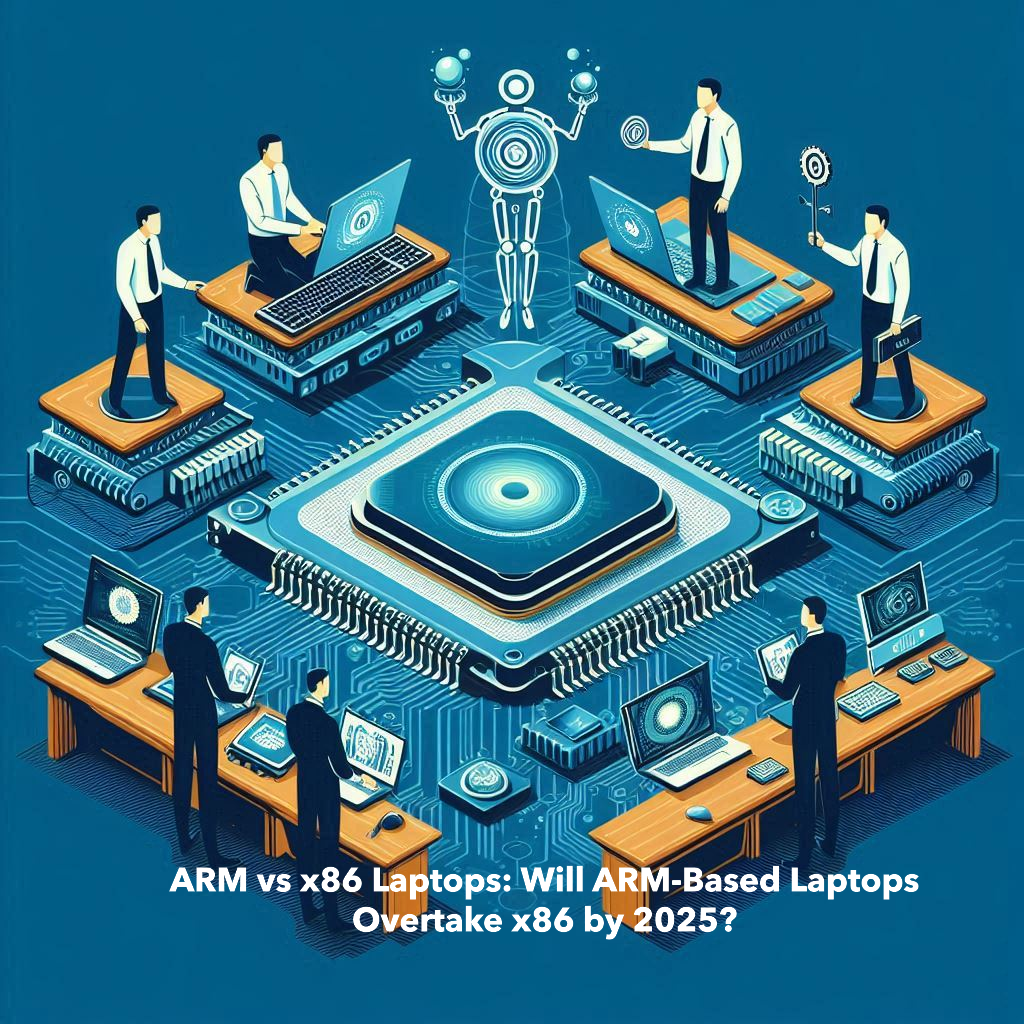ARM vs x86 Laptops: Will ARM-Based Laptops Overtake x86 by 2025? – Best Tech

ARM vs x86 Laptops: Will ARM-Based Laptops Overtake x86 by 2025?
ARM vs x86 Laptops: Will ARM-Based Laptops Overtake x86 by 2025?: The tech landscape of laptops has undergone a seismic shift over the past few years. The ongoing battle between ARM and x86 laptop architectures has become a defining narrative of this evolution. As 2025 approaches, we delve into the strengths, weaknesses, and future potential of ARM-based laptops and x86 laptops to uncover which architecture is poised to dominate.
Meta Description: ARM vs x86 Laptops
Explore the future of ARM vs x86 laptops in 2025. Discover how ARM-based laptops challenge x86 laptops with battery life, portability, and performance.
The Rise of ARM-Based Laptops – ARM vs x86 Laptops
ARM (Advanced RISC Machine) architecture, originally designed for mobile devices, has made impressive strides in the laptop market. Companies like Apple, with its M1, M2, and rumored M3 processors, have demonstrated the immense potential of ARM laptops. Let’s explore why ARM is gaining traction:
1. Superior Battery Life
One of the standout features of ARM laptops is their unmatched battery efficiency. ARM’s Reduced Instruction Set Computing (RISC) architecture minimizes power consumption without compromising performance. For instance, the MacBook Air with M1 has consistently delivered over 15 hours of real-world usage, a benchmark that most x86 laptops struggle to meet.
2. Portability and Thermal Management
ARM processors run cooler and require less elaborate cooling systems than their x86 counterparts. This translates to slimmer, lighter designs—a significant advantage for ultraportable laptops. The fanless designs of some ARM laptops are a testament to this efficiency.
3. Performance Per Watt
The performance-per-watt metric is crucial in today’s eco-conscious world. ARM’s ability to deliver excellent performance with minimal power draw has positioned it as a leader in this domain. With advancements in ARM chip designs, the performance gap with x86 is narrowing rapidly.
4. Unified Memory Architecture (UMA)
Many ARM laptops, like Apple’s M-series devices, employ a Unified Memory Architecture. UMA allows the CPU, GPU, and other components to share the same memory pool, resulting in faster data access and smoother multitasking.
The Legacy and Dominance of x86 Laptops – ARM vs x86 Laptops
x86 architecture, pioneered by Intel and AMD, has been the backbone of the laptop industry for decades. Despite ARM’s rise, x86 laptops continue to hold significant ground. Here’s why:
1. Raw Performance
For applications demanding brute computational power, x86 laptops often have the upper hand. High-performance gaming laptops and professional workstations powered by Intel Core i9 or AMD Ryzen 9 processors deliver exceptional speed and multitasking capabilities.
2. Broad Software Compatibility
The x86 architecture’s longevity has fostered an extensive ecosystem of software. From legacy enterprise applications to high-end gaming and creative tools, x86 laptops boast unparalleled compatibility. Although ARM is catching up, some software still runs more efficiently on x86 platforms.
3. Customization and Upgradability
Unlike most ARM-based laptops, x86 laptops often provide more customization options. Users can upgrade RAM, storage, and sometimes even CPUs, offering greater flexibility for enthusiasts and professionals.
4. Gaming and Specialized Workloads
The gaming industry, in particular, relies heavily on x86 laptops. Powerful GPUs and support for features like ray tracing, paired with x86 CPUs, make these devices the go-to choice for gamers and content creators.
Key Performance Metrics: ARM vs x86 Laptops
To make an informed comparison, let’s evaluate ARM and x86 laptops across key metrics:
1. Battery Life
- ARM: Generally lasts longer due to its energy-efficient design. ARM laptops often boast over 15 hours of battery life.
- x86: While improving, most x86 laptops average 8-10 hours of battery life in real-world scenarios.
2. Performance
- ARM: Suitable for general productivity, web browsing, and even some creative tasks. Apple’s M-series chips have proven capable in video editing and 3D rendering.
- x86: Dominates in raw performance for gaming, scientific simulations, and tasks requiring heavy multitasking.
3. Software Support
- ARM: Gaining momentum with native app support, but still lags in legacy software compatibility.
- x86: Offers nearly universal compatibility, a crucial factor for many professionals.
4. Price
- ARM: Often competitively priced, with entry-level models offering excellent value.
- x86: Covers a broader price range, from budget laptops to premium gaming rigs.
Challenges Facing Each Architecture – ARM vs x86 Laptops
ARM Laptops: ARM vs x86 Laptops
- Software Ecosystem: Despite progress, many enterprise applications and games are not optimized for ARM.
- Market Perception: ARM laptops are sometimes perceived as less capable than x86 counterparts.
- Upgradability: Most ARM laptops lack the modularity of x86 systems.
x86 Laptops:
- Power Efficiency: Despite innovations, x86 processors remain more power-hungry.
- Heat Management: Higher power draw leads to increased heat generation, necessitating bulkier cooling solutions.
- Weight and Portability: Heavier designs can be a drawback for frequent travelers.
Innovations Shaping the Future – ARM vs x86 Laptops
ARM
- Advanced Chip Designs: Companies like Apple, Qualcomm, and Samsung are pushing the boundaries with 3nm and even smaller nodes.
- AI Integration: ARM chips are increasingly incorporating dedicated AI accelerators, enhancing tasks like image processing and machine learning.
- Cross-Platform Compatibility: Efforts to improve compatibility with x86 software are accelerating, bolstering ARM’s appeal.
x86
- Hybrid Architectures: Intel’s Alder Lake and AMD’s Ryzen 7000 series feature hybrid designs combining high-performance and efficiency cores.
- Smaller Nodes: The shift to 3nm and beyond is helping x86 chips close the efficiency gap.
- Collaborations with GPU Makers: Partnerships with NVIDIA and AMD are yielding laptops with unprecedented gaming and creative performance.
Market Trends and Projections – ARM vs x86 Laptops

ARM Laptops in 2025
Analysts predict that ARM laptops will capture a significant share of the market by 2025. The convergence of performance and efficiency makes them attractive for mainstream users and enterprises alike.
Apple’s leadership in ARM technology, combined with Qualcomm’s advances, ensures steady growth.
x86 Laptops in 2025
x86 laptops will continue to dominate in areas requiring peak performance. However, their market share may shrink as ARM gains traction.
Innovations in efficiency and hybrid core designs will play a critical role in maintaining competitiveness.
Conclusion: The Road to 2025 – ARM vs x86 Laptops
The question of whether ARM or x86 laptops will rule 2025 does not have a straightforward answer. Instead, the landscape will likely see a coexistence of these architectures, each excelling in different domains:
- ARM Laptops: Ideal for users prioritizing battery life, portability, and efficient performance.
- x86 Laptops: The go-to choice for power users, gamers, and professionals demanding maximum performance.
As ARM continues to mature and x86 evolves to meet new challenges, consumers in 2025 will enjoy a wealth of choices tailored to diverse needs. The ultimate winner will be determined by how effectively these architectures address emerging trends and user demands.
FAQs – ARM vs x86 Laptops
1. Are ARM laptops good for gaming?
ARM laptops are improving but still lag behind x86 laptops in gaming due to limited GPU options and software compatibility.
2. Will x86 laptops become obsolete?
Unlikely. While ARM is gaining ground, x86’s raw power and software support ensure its relevance, especially for specialized tasks.
3. What’s the best choice for students in 2025?
ARM laptops may offer better value for students, thanks to their battery life and portability. However, x86 laptops could be better for engineering or creative programs requiring specific software.
4. Which architecture is better for developers?
It depends on the target platform. Developers focused on cross-platform applications may prefer ARM laptops, while those working on legacy systems might stick with x86.
Final Thoughts
The ARM vs x86 debate is not just about technology; it’s about the evolving needs of users. As innovations continue to reshape both architectures, 2025 promises an exciting era of choice and competition in the laptop market.
For ARM Laptops – ARM vs x86 Laptops
- Best ARM laptops for students in 2025
- ARM-based laptops with the longest battery life
- Advantages of ARM laptops over x86 architecture
- ARM laptops for developers: What to consider in 2025
- Affordable ARM laptops for everyday use
For x86 Laptops – ARM vs x86 Laptops
- High-performance x86 laptops for gaming
- x86 laptops with customizable hardware options
- Best x86 laptops for creative professionals in 2025
- x86 laptops vs ARM for software compatibility
- Top x86 laptops for heavy multitasking
Performance Comparison – ARM vs x86 Laptops
- ARM vs x86 laptops for professional video editing
- Battery life comparison: ARM laptops vs x86 laptops
- ARM vs x86 laptops: Gaming performance analysis
- Which is faster: ARM or x86 laptops in real-world tasks?
- ARM vs x86 laptops for enterprise software
SEO and Trends
- Future of ARM laptops in 2025 market trends
- Will x86 laptops survive the rise of ARM by 2025?
- Emerging innovations in ARM and x86 laptop architectures
- ARM laptops vs x86: Pros and cons in 2025
- ARM laptops for the eco-conscious consumer
- ARM-based laptops market share 2025
- Future of laptop processors: ARM vs x86
- Best laptops for architecture students 202
- ARM vs x86 performance comparison
- Top x86 laptops for developers and gamers in 2025
- Nvidia’s ARM-based desktop CPU plans
- MSI 2025 gaming laptops with Nvidia, Intel, and AMD


